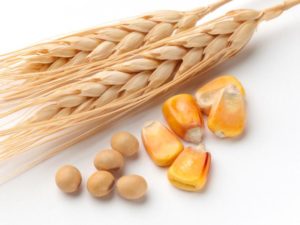 Grain futures were mixed on Monday with wheat and soybeans gaining, while corn fell as rain and cooler weather are expected to improve soil moisture, thus fueling crop outlook.
Grain futures were mixed on Monday with wheat and soybeans gaining, while corn fell as rain and cooler weather are expected to improve soil moisture, thus fueling crop outlook.
On the Chicago Board of trade, corn futures for September delivery traded at $5.4063 a bushel at 12:15 GMT, down 0.47% on the day. Prices ranged between days high and low of $5.4438 and $5.3650 per bushel respectively. The grain settled 0.58% lower last week after tumbling 0.18% the preceding one.
MDA Weather Services said on July 19 that rain and lower temperatures this week are expected to improve soil moisture, boosting crop outlook in the west-central and southwestern parts of the Midwest. This is the main corn and soybean growing region.
Last week, the U.S. Department of Agriculture confirmed expectations for reduction in the total output to 13.95 billion bushels, down from 14.005. However, this is still an all-time record high and is 29% higher than last years drought damaged crop. This years global stockpiles are projected to rise to 150.97 million tons by the end of the 2013-2014 marketing year, 22% more than the previous period. According to a Bloomberg survey, corn traders are most bearish since 2009 with 15 out of 23 analysts betting prices will fall this week. The grain has shed 29% so far this year.
Luke Mathews, a commodity strategist at Commonwealth Bank of Australia, wrote in a report, citing World Weather Inc.: “Erratic rainfall fell across the U.S. Midwest over the weekend and frequent rainfall is forecast over the coming 10 days. The environment should remain supportive for pollination and yield prospects, which in turn may result in further downward price pressure.”
Last Monday, the USDA said crop quality as of July 14 was far better than last year’s drought-damaged crop, but worsened compared to the preceding week. As of July 14, 9% of the crop was categorized as “Very poor” and “Poor”, 25% as “Fair” and 66% was rated good-excellent. During the preceding week, 8% of the crop fell in the “Very poor” and “Poor” categories, 24% in “Fair” and the remaining 68% were rated as “Good” and “Excellent”.
Soybeans gain
Meanwhile, soybeans for August delivery advanced and traded at $15.0488 a bushel at 12:16 GMT, up 0.97% on the day. Prices ranged between days high and low of $15.0738 and $14.8700 a bushel respectively. The oilseed surged 1.2% on Friday and extended last weeks advance to over 4.3%.
The USDA said in its weekly crop progress report last Monday that soybeans blooming advanced last week, but still fell behind the previous year’s pace. As of July 14, 26% of soybeans plants had bloomed, compared to 10% during the preceding week. This however was well below 2012′s 63% reading and the five-year average of 40%.
As for the crop condition, soybeans quality is a lot better this year, but has worsened compared to the previous week. As of July 14, 8% of the crop was categorized as “Very poor” and “Poor”, compared to 7% in the previous week and 30% a year earlier. Meanwhile, 27% of soybeans fell in the “Fair” category, 1% higher than the prior week and below last year’s 36%. As for the premium quality, 65% was rated good-excellent, below the preceding week’s 67% and well above 2012′s 34%.
Wheat gains as well
Meanwhile, wheat also gained. The September contract traded at $6.6588 a bushel at 12:19 GMT, up 0.28% for the day. Prices ranged between $6.6765 and $6.6088 per bushel. The grain declined four out of five days last week and settled 2.5% lower on a weekly basis after surging 3.2% the previous one.
The USDA said in its weekly crop progress report last Monday that 71% of the spring wheat crop crop was headed as of July 14, well above the preceding week’s 45% and nearing the five-year average 73%. During the comparable week last year, 93% of the wheat was headed.
Spring wheat condition was overall better than the 2012 season, but slightly worse compared to the preceding week. As of July 14, 5% of the crop was rated very poor-poor, the same like the previous week, but below last year’s 8%. Meanwhile, 25% was categorized as “Fair”, compared to 23% in the preceding week and 27% in 2012. As for the premium quality, 70% of the crop was rated as good-excellent in the week ending July 14, compared to 72% in the preceding one and 65% a year earlier.





